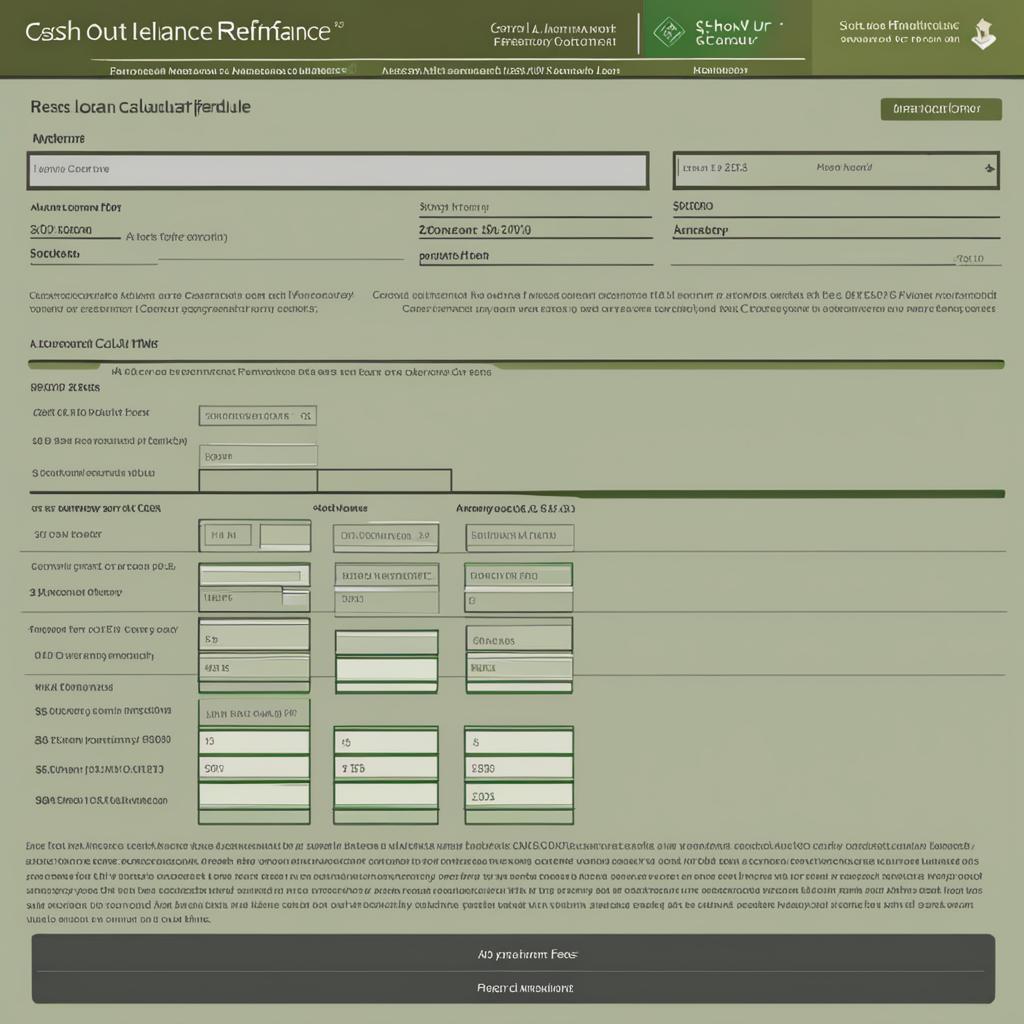A cash-out refinance is a financial tool that allows homeowners to tap into the equity they have built in their homes and receive a lump sum of cash. It involves replacing the existing mortgage with a new loan that is larger than the current loan balance, giving homeowners the opportunity to borrow against the value of their property.
With a cash-out refinance, homeowners can use the cash they receive for various purposes, such as making home improvements, paying off high-interest debt, or even funding major life events. By leveraging the equity in their homes, they can access funds that may otherwise be tied up and put them to use in ways that benefit their financial goals.
Key Takeaways
- A cash-out refinance allows homeowners to borrow against the equity they have built in their homes.
- By replacing the existing mortgage with a new, larger loan, homeowners can receive a lump sum of cash.
- The cash received can be used for home improvements, debt consolidation, or other financial goals.
- Cash-out refinances may offer lower interest rates compared to credit cards and other forms of borrowing.
- Before pursuing a cash-out refinance, homeowners should carefully consider their financial situation and goals.
How Does a Cash-Out Refinance Work?
When considering a cash-out refinance, it’s important to understand the process and requirements involved. I’ll walk you through how a cash-out refinance works, step by step.
Cash-Out Refinance Process
- Determine eligibility: To qualify for a cash-out refinance, you’ll need to meet specific requirements. These typically include having a minimum credit score of 580 and a debt-to-income ratio below 50%. Additionally, you’ll need to have built up equity in your home.
- Calculate your cash-out amount: The amount of cash you can receive through a cash-out refinance is determined by the loan-to-value (LTV) ratio. Most lenders allow a maximum LTV of 80%, meaning you can borrow up to 80% of your home’s value. However, VA loans may offer the option to borrow the full amount of your existing equity. Use a cash-out refinance calculator to estimate how much cash you’ll be eligible to receive.
- Apply for the new loan: Once you’ve determined your eligibility and cash-out amount, you can start the application process. Select a lender and submit your application, providing all required documentation. This may include proof of income, bank statements, and other financial records.
- Underwriting and approval: After submitting your application, the lender will review your documents and evaluate your financial profile. They’ll assess your creditworthiness, income stability, and overall risk. If approved, you’ll receive a loan estimate outlining the terms and conditions of the new loan.
- Closing the loan: Once you’ve reviewed and accepted the loan estimate, the closing process begins. This involves signing the necessary paperwork and paying any closing costs or fees. As part of the closing, your existing mortgage will be paid off with the proceeds from the cash-out refinance.
- Receiving the cash-out amount: After closing, you’ll receive the difference between your new loan amount and the amount needed to pay off your original mortgage. This cash can be used for various purposes, such as home improvements, debt consolidation, or other financial needs.
By following this process, you can tap into your home’s equity and access the cash you need. However, remember that a cash-out refinance is a financial decision that should be carefully considered based on your specific circumstances and goals.
Benefits of a Cash-Out Refinance
A cash-out refinance offers numerous financial benefits that can help homeowners achieve their goals and improve their financial situation.
1. Funding Home Improvements or Renovations
One of the primary advantages of a cash-out refinance is the ability to access the equity in your home to fund essential home improvements or renovations. Whether you want to upgrade your kitchen, add an additional bedroom, or enhance your outdoor living space, a cash-out refinance can provide the necessary funds.
2. Consolidating Debt
Another benefit of a cash-out refinance is debt consolidation. By refinancing your mortgage and taking out additional cash, you can pay off high-interest debt, such as credit card balances or personal loans. Consolidating debt through a cash-out refinance can simplify your monthly payments, potentially reduce your overall interest expenses, and help you become debt-free sooner.
3. Access to Lower Interest Rates
Credit cards often come with high interest rates, making them an expensive way to borrow money. In contrast, cash-out refinancing typically offers lower interest rates, especially when compared to credit cards and other unsecured loans. By using a cash-out refinance, you can leverage the equity in your home to borrow at a more affordable rate, potentially saving you thousands of dollars in interest over time.
4. Opportunities for Investments or Savings
A cash-out refinance can also provide you with the much-needed funds to pursue investment opportunities or build your savings. Whether you want to invest in real estate, start a business, or contribute to your retirement fund, accessing the equity in your home through a cash-out refinance can give you the financial flexibility to achieve your goals.
5. Potential Tax Deductibility
If you use the cash-out amount from your refinance for home improvements, you may be eligible to deduct the interest paid on that portion of your loan. Consult with a tax professional to understand the specific requirements and potential tax benefits of using a cash-out refinance for home improvements.
Overall, a cash-out refinance provides homeowners with a range of benefits, from funding home improvements and consolidating debt to accessing lower interest rates and creating opportunities for investments or savings. It’s a versatile financial tool that can help you unlock the potential in your home and achieve your financial objectives.

Calculating Cash-Out Refinance Amount
When considering a cash-out refinance, it’s important to determine how much cash you can receive from the transaction. The cash-out amount is based on two key factors: the value of your home and the loan-to-value (LTV) ratio set by lenders. Here’s how it works:
- Home Value: Typically, homeowners can borrow up to 80% of their home’s value through a cash-out refinance. To calculate the maximum amount, multiply your home’s appraised value by 0.8. For example, if your home is appraised at $300,000, the maximum cash-out amount would be $240,000. (SEO: cash out refinance calculator)
- LTV Ratio: The LTV ratio is the percentage of your home’s value that you can borrow. Lenders may set different LTV limits, but as a general guideline, an 80% LTV is common for conventional loans. However, if you have a VA loan, you may be able to borrow up to the full amount of your existing equity. (SEO: how much cash can you get on a refinance)
To get a more accurate estimate of the cash-out amount you may be eligible for, it’s recommended to use a cash-out refinance calculator. These online tools take into account various factors, such as your home’s value, current mortgage balance, and potential closing costs, to provide you with an estimate of the cash you can receive. Keep in mind that the calculator’s results are estimates and may vary depending on your individual financial situation and lender requirements.
Example Cash-Out Refinance Calculation:
Let’s say your home is appraised at $250,000, and you have an existing mortgage balance of $150,000. If the maximum LTV allowed by your lender is 80%, you could potentially qualify for a cash-out refinance of up to $70,000 ($250,000 x 0.8 – $150,000).
Remember, the cash-out refinance amount is not the same as the amount you will receive in cash. The total cash-out amount will be reduced by any existing mortgage balance, closing costs, and other fees associated with the refinance. It’s important to carefully review the loan terms, costs, and potential impacts on your overall financial situation before proceeding with a cash-out refinance.
Next, we’ll explore the differences between a cash-out refinance and a second mortgage to help you make an informed decision.

Cash-Out Refinance vs. Second Mortgage
When it comes to accessing the equity in your home, you have a few options to consider. Two popular choices are a cash-out refinance and a second mortgage. While they both allow you to tap into your home’s equity, there are some key differences to be aware of.
Let’s start by looking at how a cash-out refinance works. With a cash-out refinance, you replace your existing mortgage with a new loan that is larger than your current balance. The extra funds are then given to you in cash, which you can use for various purposes such as home improvements, debt consolidation, or other financial needs. This means you will only have one mortgage payment, combining your old loan and the additional amount borrowed.
On the other hand, a second mortgage, also known as a home equity loan or a home equity line of credit (HELOC), is an additional loan that is taken out on top of your existing mortgage. Unlike a cash-out refinance, a second mortgage does not replace your original loan. Instead, it becomes a separate monthly payment, and you will have two mortgages to manage.
Now, let’s compare the two options in terms of interest rates. In general, cash-out refinance loans tend to have lower interest rates compared to second mortgages. This is because a cash-out refinance involves refinancing your entire mortgage, which is considered less risky for lenders. In contrast, a second mortgage is an additional loan on top of your existing one, which presents a higher risk.
“A cash-out refinance typically offers lower interest rates compared to second mortgages, making it a more affordable option in many cases.”
By choosing a cash-out refinance, you can potentially save money on interest payments over the life of the loan.
To summarize, a cash-out refinance offers the advantage of consolidating your existing mortgage and accessing cash in a single loan. It typically comes with lower interest rates compared to a second mortgage. However, it’s important to carefully consider your financial situation and goals before making a decision. Evaluate your monthly budget, long-term repayment plans, and the purpose of the funds you wish to access.
Next, let’s take a closer look at the interest rates for cash-out refinance loans.
Cash-Out Refinance Interest Rates
The interest rates for cash-out refinance loans are influenced by various factors, such as your credit score, loan-to-value ratio (LTV), and the current market conditions. Generally, cash-out refinance rates tend to be slightly higher than rates for regular refinances due to the increased loan amount and perceived risk for lenders.
However, borrowers with a high credit score can potentially qualify for lower interest rates. It’s important to compare rates from multiple lenders to make sure you secure the best possible rate for your cash-out refinance loan.
Now let’s move on to the eligibility requirements for a cash-out refinance.
Cash-Out Refinance Rates
When considering a cash-out refinance, one important factor to keep in mind is the associated interest rates. Cash-out refinance rates refers to the interest rates charged by lenders for this type of mortgage loan.
Typically, cash-out refinance rates are slightly higher compared to rates for regular refinances. This is because lenders view cash-out refinances as a higher risk due to the borrower taking on additional debt.
However, it’s worth noting that borrowers with a high credit score may qualify for lower rates. Lenders often offer more competitive rates to borrowers who have demonstrated a responsible borrowing history and strong creditworthiness. So, if you have a good credit score, you may be able to secure a more favorable interest rate for your cash-out refinance.
To ensure you get the best possible rate, it’s crucial to shop around and compare rates from multiple lenders. By doing so, you can evaluate different offers and choose the one that provides the most attractive terms for your specific financial situation.
Ultimately, securing a lower interest rate for your cash-out refinance can result in significant savings over the life of the loan, so it’s worth investing time and effort in finding the best rate for your needs.

Comparing Interest Rates for Cash-Out Refinance
Here is a table comparing interest rates from different lenders for a cash-out refinance:
| Lender | Interest Rate |
|---|---|
| ABC Bank | 3.5% |
| XYZ Mortgage | 3.75% |
| 123 Finance | 4.1% |
As shown in the table, interest rates can vary among lenders. It’s essential to evaluate the terms, including the interest rate, offered by different lenders to choose the one that suits your financial goals and preferences.
Cash-Out Refinance Eligibility
To be eligible for a cash-out refinance, homeowners need to meet specific requirements. These requirements include:
- Minimum Credit Score: Homeowners should have a minimum credit score of 620.
- Debt-to-Income Ratio: The debt-to-income ratio should be below 50%.
- Equity in Home: Homeowners must have at least 20% equity in their home.
It’s important to note that different loan types, such as conventional, FHA, and VA loans, may have slightly different eligibility criteria. Therefore, it’s recommended to consult with a mortgage lender or broker to determine the specific cash-out refinance requirements based on the desired loan type.
Meeting these eligibility criteria increases the chances of being approved for a cash-out refinance and accessing the equity in one’s home.
How to Apply for a Cash-Out Refinance
Applying for a cash-out refinance is a straightforward process that follows a similar path to applying for a regular mortgage. Here are the steps to get started:
- Choose a Lender: Begin by researching and comparing lenders to find the one that offers the best terms and rates for your cash-out refinance.
- Submit an Application: Once you have chosen a lender, fill out their loan application form, providing accurate and complete information about your financial situation, property, and intended use of the cash-out funds.
- Provide Documentation for Underwriting: Your lender will ask for various documents to verify your income, employment, assets, and property details. These documents may include pay stubs, bank statements, tax returns, and property appraisals.
- Complete the Underwriting Process: The lender will review your application and documentation to evaluate your eligibility and determine the terms of your cash-out refinance loan.
- Proceed with the Closing Process: If your application is approved, you will move forward with the closing process. This usually involves signing the necessary legal documents and paying any closing costs associated with the loan.
- Receive the Cash-Out Amount: After the closing, you can expect to receive the cash-out funds within a few days. The money can be used for purposes such as home improvements, debt consolidation, or other financial needs.
Remember, each lender may have slightly different application requirements and timelines, so it’s important to familiarize yourself with their specific process and ask any questions along the way.

| Pros of Applying for a Cash-Out Refinance | Cons of Applying for a Cash-Out Refinance |
|---|---|
| Access to a significant amount of cash for various financial needs. | Increase in mortgage debt, potentially leading to higher monthly payments. |
| Potential tax benefits if the cash-out funds are used for home improvements. | Potential risk of foreclosure if unable to meet the increased monthly payments. |
| Opportunity to consolidate high-interest debts into a single, lower-interest loan. | Decreased home equity, which may limit future refinancing or borrowing options. |
| Possibility of securing a lower interest rate compared to other forms of borrowing. | Closing costs and fees associated with the cash-out refinance process. |
| Flexibility in using the cash-out funds for various purposes, such as investments or emergency expenses. | The need to meet specific eligibility criteria, including credit score, income, and equity requirements. |
Considerations Before a Cash-Out Refinance
Before committing to a cash-out refinance, it’s crucial for homeowners to carefully evaluate their financial situation and consider a few important factors. By understanding these considerations, they can make an informed decision and ensure that a cash-out refinance aligns with their long-term goals. Here are some things to know before proceeding:
- Equity Requirements: Homeowners should be aware that they may need to leave a certain amount of equity in their home when doing a cash-out refinance. Lenders typically require a minimum loan-to-value (LTV) ratio, meaning homeowners must maintain a certain percentage of equity in their property.
- Closing Costs: Just like any other mortgage transaction, a cash-out refinance involves closing costs. These costs can include appraisal fees, origination fees, title insurance, and other expenses associated with the loan. Homeowners should consider these costs and factor them into their decision-making process.
- Increased Monthly Payments: With a cash-out refinance, homeowners will likely see an increase in their monthly mortgage payment. This is because they are borrowing a larger amount of money and extending the repayment term. It’s crucial to carefully evaluate whether the higher monthly payments fit within their budget.
By considering these factors, homeowners can ensure that a cash-out refinance is the right option for them. It’s essential to consult with a trusted mortgage professional who can provide personalized advice based on their unique financial situation and goals.
Case Study: Weighing the Pros and Cons
“Before deciding on a cash-out refinance, I analyzed my equity requirements, estimated closing costs, and compared my existing monthly payment with the projected increase. This helped me understand the potential benefits and drawbacks, allowing me to make an informed decision. Ultimately, I determined that a cash-out refinance was the right choice for my financial goals.”
Cash-Out Refinance Alternatives
If a cash-out refinance doesn’t seem like the right option, homeowners can consider other alternatives that may better suit their needs. Here are a few alternative options:
1. Home Equity Loans
A home equity loan is a type of loan that allows homeowners to borrow against the equity they have built in their homes. With a home equity loan, homeowners receive a lump sum of money upfront, which they can use for various purposes. The loan is secured by the home, and repayment terms and interest rates are generally fixed.
2. Home Equity Lines of Credit (HELOCs)
A home equity line of credit, or HELOC, is a revolving line of credit that allows homeowners to borrow against the equity in their homes. Similar to a credit card, homeowners can access funds as needed, up to a predetermined credit limit. HELOCs often have variable interest rates and flexible repayment terms.
3. Personal Loans
Another alternative to a cash-out refinance is a personal loan. Personal loans are typically unsecured, meaning they do not require collateral. Homeowners can use personal loans for a variety of purposes, such as home improvements or debt consolidation. Interest rates for personal loans vary depending on the borrower’s creditworthiness.
4. Credit Cards
Credit cards can also be an alternative for accessing funds instead of a cash-out refinance. Homeowners can use credit cards for smaller expenses or short-term funding needs. However, it’s important to note that credit cards usually have higher interest rates compared to other loan options, so careful consideration should be given to repayment plans.
Each alternative option has its own advantages and considerations, so homeowners should carefully evaluate their financial situation and goals before deciding which option is best for them.
| Alternative Option | Advantages | Considerations |
|---|---|---|
| Home Equity Loans | May offer lower interest rates compared to credit cards | Requires using home as collateral |
| HELOCs | Flexible access to funds as needed | Variable interest rates can increase over time |
| Personal Loans | Can be unsecured, no collateral required | Interest rates may be higher compared to home equity options |
| Credit Cards | Provides short-term access to funds | Usually higher interest rates compared to other options |
Cash-Out Refinance Risks
While a cash-out refinance can be a useful financial tool, it’s important to be aware of the potential drawbacks and risks associated with this type of mortgage strategy. Consider the following risks before proceeding with a cash-out refinance:
1. Higher Risk of Foreclosure
One significant risk of a cash-out refinance is the increased possibility of foreclosure if you’re unable to make the higher monthly mortgage payments. By taking on a larger loan amount, your monthly repayment obligations will likely increase. Failure to meet those obligations could put your home at risk.
2. Reduced Home Equity
It’s crucial to remember that borrowing against your home’s equity through a cash-out refinance decreases the overall equity in your property. This reduction in home equity can have repercussions on your ability to access future financing opportunities or negatively impact your potential proceeds if you decide to sell your home.
To illustrate the potential drawback more clearly, consider the hypothetical example below:
| Before Cash-Out Refinance | After Cash-Out Refinance |
|---|---|
| Home Value | $300,000 |
| Outstanding Mortgage Balance | $200,000 |
| Equity | $100,000 |
| (Scenario: Cash-Out Refinance) | |
| New Mortgage Amount | $250,000 |
| Equity Remaining | $50,000 |
“Borrowing against your home’s equity through a cash-out refinance entails the potential effect of diminishing the overall equity in your property, which can be a risk when considering future selling or refinancing opportunities.”
While a cash-out refinance can provide immediate funds for important expenses, it’s crucial to carefully evaluate the potential risks and drawbacks before making a decision. Assess your financial situation, consider your long-term goals, and consult with a mortgage professional to determine if a cash-out refinance aligns with your overall financial strategy.
Cash-Out Refinance Example
To illustrate how a cash-out refinance works, let’s consider an example. Suppose a homeowner purchased a home for $200,000, has paid off $60,000, and wants to make $20,000 in renovations. With a cash-out refinance, their new mortgage would be $160,000 ($140,000 remaining balance + $20,000 for renovations), and they would receive the $20,000 in cash a few days after closing.
Conclusion
A cash-out refinance can be a valuable financial tool for homeowners looking to access funds for various purposes, such as home improvements or debt consolidation. By leveraging the equity they have built in their homes, homeowners can replace their existing mortgage with a new, larger loan and receive the difference in cash.
However, before pursuing a cash-out refinance, it is crucial for homeowners to evaluate their financial situation and goals carefully. It is essential to consider the potential risks involved, such as the increased monthly mortgage payment and the impact on future equity. Additionally, exploring alternative options, such as home equity loans or personal loans, may be worth considering to ensure the chosen path aligns with long-term objectives and financial stability.
In summary, a cash-out refinance can provide homeowners with the means to accomplish their financial objectives and access the funds they need. By understanding the process, weighing the potential risks and alternatives, and consulting with mortgage professionals, homeowners can make informed decisions that support their financial well-being and achieve their desired outcomes.
FAQ
What is a Cash-Out Refinance?
A cash-out refinance allows homeowners to borrow against the equity they have built in their homes by taking out a new mortgage that is larger than their current loan balance. This provides them with cash that can be used for various purposes, such as home improvements or debt consolidation.
How Does a Cash-Out Refinance Work?
The process of a cash-out refinance is similar to obtaining a regular mortgage. Homeowners must meet certain requirements, such as having a minimum credit score of 580 and a debt-to-income ratio below 50%. They can borrow up to 80% of their home’s value, although VA loans allow for borrowing up to the full amount of existing equity. The cash-out refinance involves applying for a new loan, paying off the old mortgage, and receiving the difference in cash.
What Are the Benefits of a Cash-Out Refinance?
A cash-out refinance offers several financial benefits, such as the ability to fund home improvements or renovations, consolidate debt, and access lower interest rates compared to credit cards. It also provides the opportunity to free up money for investments or savings, and the interest paid on the cash-out amount may be tax-deductible if used for home improvements.
How Do I Calculate the Cash-Out Refinance Amount?
The amount of cash a homeowner can receive through a cash-out refinance is based on the home’s value and the loan-to-value (LTV) ratio set by lenders. Typically, homeowners can borrow up to 80% of their home’s value, but VA loans allow for borrowing up to the full amount of existing equity. Using a cash-out refinance calculator can help homeowners estimate the cash-out amount they may be eligible for.
What is the Difference Between a Cash-Out Refinance and a Second Mortgage?
A cash-out refinance differs from a second mortgage in that it replaces the existing mortgage with a new, larger loan. This means homeowners have only one mortgage payment instead of two. Additionally, a cash-out refinance typically offers lower interest rates compared to second mortgages, making it a more affordable option in many cases.
What Are the Cash-Out Refinance Rates?
Cash-out refinance rates are typically higher than rates for regular refinances due to the increased risk for lenders. However, borrowers with a high credit score may qualify for lower rates. It’s important to shop around and compare rates from multiple lenders to secure the best possible rate for a cash-out refinance.
Am I Eligible for a Cash-Out Refinance?
To be eligible for a cash-out refinance, homeowners must meet certain requirements, including having a minimum credit score of 620, a debt-to-income ratio below 50%, and at least 20% equity in their home. Different loan types, such as conventional, FHA, and VA loans, may have slightly different eligibility criteria.
How Do I Apply for a Cash-Out Refinance?
The application process for a cash-out refinance is similar to that of a regular mortgage. Homeowners need to choose a lender, submit an application, and provide documentation for underwriting. Once approved, they can proceed with the closing process, and the cash-out amount is typically received a few days after closing.
What Should I Consider Before a Cash-Out Refinance?
Before committing to a cash-out refinance, homeowners should consider a few things. They should be aware that they may need to leave a certain amount of equity in their home, closing costs will be involved, and their monthly mortgage payment will likely increase. It’s important to carefully evaluate the financial implications and ensure that a cash-out refinance aligns with their long-term goals.
What Are the Alternatives to a Cash-Out Refinance?
If a cash-out refinance doesn’t seem like the right option, homeowners can consider alternatives. These may include home equity loans, home equity lines of credit (HELOCs), personal loans, or credit cards. Each option has its own advantages and considerations, so homeowners should carefully evaluate which one best meets their needs.
What Are the Risks of a Cash-Out Refinance?
There are some risks associated with a cash-out refinance. Homeowners may be at a higher risk of foreclosure if they are unable to make the increased monthly mortgage payments. It’s also important to remember that borrowing against home equity decreases the overall equity in the home, potentially impacting future selling or refinancing opportunities.
Can You Provide an Example of a Cash-Out Refinance?
To illustrate how a cash-out refinance works, let’s consider an example. Suppose a homeowner purchased a home for 0,000, has paid off ,000, and wants to make ,000 in renovations. With a cash-out refinance, their new mortgage would be 0,000 (0,000 remaining balance + ,000 for renovations), and they would receive the ,000 in cash a few days after closing.
Our Friends
- https://www.rocketmortgage.com/learn/cash-out-refinance
- https://www.lendingtree.com/home/refinance/cash-out/
- https://www.nerdwallet.com/article/mortgages/refinance-cash-out
Money posts:
 Is Blitz Win Cash Legit? Review (2024)
Is Blitz Win Cash Legit? Review (2024)
 What Are the Different Types of Financial Advisors? (2024)
What Are the Different Types of Financial Advisors? (2024)
 Net Worth By Age Stats (+10 Ways to Improve Your Worth!) (2024)
Net Worth By Age Stats (+10 Ways to Improve Your Worth!) (2024)
 How to Save Money in College: Effective Strategies (2024)
How to Save Money in College: Effective Strategies (2024)
 How to Prepare for a Recession: Expert Strategies for Financial Resilience 2024
How to Prepare for a Recession: Expert Strategies for Financial Resilience 2024
 YNAB vs. Mint: Which Budget App Should You Use? 2024
YNAB vs. Mint: Which Budget App Should You Use? 2024
 Is Robinhood Gold Worth It? (What $5 per Month Gets You) (2024)
Is Robinhood Gold Worth It? (What $5 per Month Gets You) (2024)
 J.P. Morgan Personal Advisors Review (2024)
J.P. Morgan Personal Advisors Review (2024)

